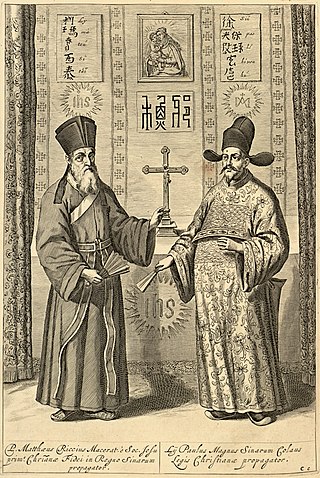
Confucius,born Kong Qiu (孔丘),was a Chinese philosopher of the Spring and Autumn period who is traditionally considered the paragon of Chinese sages,as well as the first teacher in China to advocate mass education. Much of the shared cultural heritage of the Sinosphere originates in the philosophy and teachings of Confucius. His philosophical teachings,called Confucianism,emphasized personal and governmental morality,harmonious social relationships,righteousness,kindness,sincerity,and a ruler's responsibilities to lead by virtue.

The Chinese Rites controversy was a dispute among Catholic missionaries over the religiosity of Confucianism and Chinese rituals during the 17th and 18th centuries. The debate discussed whether Chinese ritual practices of ancestor veneration and other formal rites qualified as religious,and thus incompatible with Catholic belief. The Jesuits argued that these Chinese rites were secular rituals that were compatible with Christianity,within certain limits,and should thus be tolerated. The Dominicans and Franciscans,however,disagreed and reported the issue to Rome.
This article contains information about the literary events and publications of 1687.

Figurism was an intellectual movement of Jesuit missionaries at the end of the 17th and the beginning of the 18th century,whose participants viewed the I Ching as a prophetic book containing the mysteries of Christianity,and prioritized working with the Qing Emperor as a way of promoting Christianity in China.

Xu Guangqi or HsüKuang-ch'i,also known by his baptismal name Paul or Paul Siu,was a Chinese agronomist,astronomer,mathematician,politician,and writer during the Ming dynasty. Xu was appointed by the Chinese Emperor in 1629 to be the leader of the Shixian calendar reform,which he embarked on with the assistance of Jesuits. Xu was a colleague and collaborator of the Italian Jesuits Matteo Ricci and Sabatino de Ursis and assisted their translation of several classic Western texts into Chinese,including part of Euclid's Elements. He was also the author of the Nong Zheng Quan Shu,a treatise on agriculture.

Zhang Juzheng,courtesy name Shuda,pseudonym Taiyue,was a Chinese politician who served as Senior Grand Secretary in the late Ming dynasty during the reigns of the Longqing and Wanli emperors. He represented what might be termed the "new Legalism". Aiming to ensure that the gentry worked for the state,one of his chief goals was to reform and rationalize the bureaucracy together with his political rival Gao Gong,who was concerned that offices were providing income with little responsibility. Taking the Hongwu Emperor as standard and ruling as de facto Prime Minister,Zhang's true historical significance comes from his centralization of existing reforms,positioning the reformative agency of the state over that of the gentry—the "Legalist" idea of the sovereignty of the state.

Nicolas Trigault (1577–1628) was a Jesuit,and a missionary in China. He was also known by his latinised name Nicolaus Trigautius or Trigaultius,and his Chinese name Jin Nige.

Johann(es) Schreck,also Terrenz or Terrentius Constantiensis,Deng Yuhan Hanpo 鄧玉函,Deng Zhen Lohan,was a German Jesuit,missionary to China and polymath. He is credited with the development of scientific-technical terminology in Chinese.
Missionary work of the Catholic Church has often been undertaken outside the geographically defined parishes and dioceses by religious orders who have people and material resources to spare,and some of which specialized in missions. Eventually,parishes and dioceses would be organized worldwide,often after an intermediate phase as an apostolic prefecture or apostolic vicariate. Catholic mission has predominantly been carried out by the Latin Church in practice.

Christian Wolfgang Herdtrich was an Austrian Jesuit missionary to the Qing Empire. As he wrote his works in Latin,he is also known as Christianus Herdtrich.

PhilippeCouplet,SJ (1623–1693),known in China as Bai Yingli,was a Flemish Jesuit missionary to the Qing Empire. He worked with his fellow missionaries to compile the influential Confucius,Philosopher of the Chinese,published in Paris in 1687. As his works were in Latin,he is also sometimes known as Philippus Couplet.
Louis Fan,born Fan Shouyi and also known as Luigi Fan,was the first known Chinese person to travel to Europe,return to China,and write an account of his travels. However,in traveling to Europe,he was preceded by Michael Shen Fu-Tsung,Arcadio Huang,and Rabban Bar Sauma,all of whom died abroad before returning to China.
Angelo Zottoli was an Italian Catholic priest and missionary in China and a sinologist.
Manuel Dias the Younger was a Portuguese Jesuit missionary.

Luo Wenzao was the first person of Chinese ethnicity to be appointed as a Catholic bishop. After the Qing dynasty proscribed Christianity and banished foreign missionaries in 1665,Luo became the only person in charge of the Catholic missions in China. In 1674,the Holy See first appointed Luo as a bishop. He declined it but accepted his second appointment in 1679. Due to opposition from Dominicans,he was consecrated as the apostolic vicar of Nanjing in 1685 and held the position until his death in 1691.

De Christiana expeditione apud Sinas suscepta ab Societate Jesu ... is a book based on an Italian manuscript written by the most important founding figure of the Jesuit China mission,Matteo Ricci (1552–1610),expanded and translated into Latin by his colleague Nicolas Trigault (1577–1628). The book was first published by Christoph Mang in 1615 in Augsburg.

Lodovico Buglio (1606–1682),Chinese name Li Leisi,was an Italian Jesuit mathematician and theologian. He was the first Catholic missionary to reach Sichuan,the then-westernmost province in China.

The history of the missions of the Jesuits in China is part of the history of relations between China and the Western world. The missionary efforts and other work of the Society of Jesus,or Jesuits,between the 16th and 17th century played a significant role in continuing the transmission of knowledge,science,and culture between China and the West,and influenced Christian culture in Chinese society today.
Lazzaro Cattaneo,was an Italian Jesuit missionary who invented the first tone markings for Chinese transcription.
François Noël,SJ was a Flemish Jesuit,poet,dramatist,and missionary to the Qing Empire. Nöel unsuccessfully testified in support of Chinese converts to Catholicism retaining ancestral veneration during the Chinese Rites controversy but also opposed incorporating other elements of Confucianism into Catholic practice. He also achieved notability for translating several Chinese texts for European audiences.














